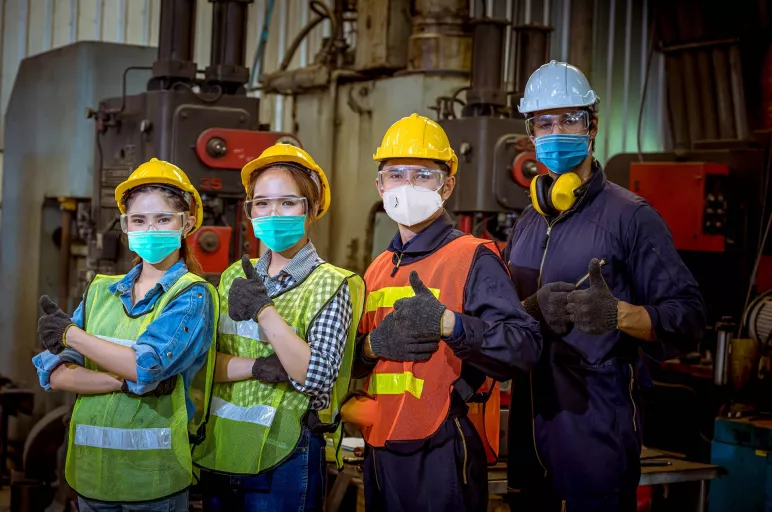
Becoming Anti-Fragile: What Manufacturing Supply Chains Can Learn From COVID-19
May 12, 2020 | Supply Chain Strategy
According to the United Nations Statistics Division, in 2018, China accounted for 28% of global manufacturing, contributing approximately $4 trillion. The COVID-19 pandemic swept through China’s major businesses and severely impacted the country’s manufacturing and distribution sector. According to Dun & Bradstreet, the hardest-hit provinces of China were responsible for roughly 90% of all the business functioning in the country. Researchers estimate that more than 5 million businesses have tier 1 or tier 2 suppliers located in one of China’s worst-affected regions.
The Knock-On Effect on the Global Value Chains
China is the chief supplier of intermediate inputs for global manufacturing companies, with about 20% of the world’s intermediate products originating from the country. China’s official measure of manufacturing activity, known as the ‘Purchasing Manager’s Index’, or PMI, dropped from 50 in January to 37.5 in February. Such a decline in output indicates a 2% reduction in exports on an annual basis.
According to the United Nations Conference on Trade and Development (UNCTAD), Chinese manufacturing is vital to the global value chain, particularly to precision instruments, machinery, automotive and communication equipment. The most affected economies are the European Union ($15 billion), the United States ($5.8 billion), Japan ($5.2 billion), South Korea ($3.8 billion), Taiwan ($2.6 billion) and Vietnam ($2.3 billion). Restrictions in China has affected companies such as Apple, Diageo, Jaguar Land Rover and Volkswagen immensely as they rely on China’s production and consumer market.
Negatives of the Just-In-Time Process
The global manufacturing industry is built on outsourcing, just-in-time inventory and thin margins, all of which combine to makes it very delicate. The Institute of Supply Management conducts monthly surveys that found that more than 70% of the manufacturing companies surveyed in late February and March were affected by supply chain disruptions caused by the coronavirus and more than 40% of these companies were not equipped to deal the disruption.
The concept of avoiding stockpiling and housing inventory proved to be very efficient for streamlining costs and operations. However, during disruptions such as pandemics and natural disasters, the threads of advantage tend to loosen up quickly. It holds true for automakers too. In 2011, Ford and other automobile companies were left scrambling for the color ‘Tuxedo Black’, a popular choice for cars that was made by only one company, Merck KGaA, in a factory in Japan that had been hit by a tsunami. This ended up causing a severe global shortage. Just-in-time manufacturing is known for its efficiency, but not for its resilience. It helps manufacturers in cutting costs but also leaves them less resilient to sudden shocks and supply shortages, as was seen in the last few months.
What Makes Manufacturers Resilient?
Most manufacturers are aware of their immediate and critical suppliers. But they don’t always know their suppliers’ supplier. This leads to a gap in understanding the hidden vulnerability in supply chains, making it difficult to predict the impact of shortages and stoppages on their output.
- Rethink Just-In-Time Manufacturing: Although creating economies of scale and volume lowers costs, companies do not have many options once there is a letdown. This makes it crucial for manufacturers to invest in system resilience and multisource strategies. For instance, in the wake of the tsunami that wiped out their Tuxedo Black pigment, Merck created another pigment and started stockpiling it at places besides their Japanese plant. By 2013, the pigment was also being made in another factory in Germany.
- Establish a Digital Foundation or Build an Anti-Fragile Supply Chain: Even though it sounds basic in this day and age, the fact is that paper and manual processes control most supply chains. Making the process digital is the foundational element for building an anti-fragile supply chain. This will help decision-makers to spot problems quicker and make informed choices to manage disruptions. Also, it improves the ability to collaborate with suppliers and makes it easier and quicker to find alternative suppliers, which is imperative during times of disruption.
- Revisiting the Supply Chain: It is necessary to revisit the supply chain and mitigate risks. Suppliers should develop a process to continuously identify and monitor risks. They should assess various tiers of suppliers to have a clear picture of the entire chain. They should add multiple suppliers not only in terms of the number of suppliers, but also in terms of geography, to and add diversity to their supply chain.
Conclusion
Once COVID-19 is under control, we must not be naïve about the fact that similar situations will arise in the future. Manufacturers can not rest on their successes in surviving this disruption. Manufacturers need to rethink their supply chains and think about things more broadly. Will the consolidation of suppliers help during disruptions? Will adopting digitization make their systems antifragile? By building robust action plans, manufacturers can be in a much better position than what they are in now to monitor pinch points and implement other measures to deal during the time of crisis.
References
- https://www.theverge.com/2020/3/13/21177024/apple-just-in-time-manufacturing-china-coronavirus-supply-chain
- https://www.ttiinc.com/content/ttiinc/en/resources/marketeye/categories/industry/me-custer-20200304.html
- https://unctad.org/news/coronavirus-outbreak-has-cost-global-value-chains-50-billion-exports
- https://coronavirus.marsh.com/us/en/insights/risk-in-context/coronavirus-manufacturing-supply-chains.html
- https://www.supplychaindigital.com/supply-chain-management/coronavirus-and-antifragile-supply-chain
- https://www.axios.com/global-manufacturing-coronavirus-china-1b24db8b-2022-4efc-be3a-6a272cae1627.html



